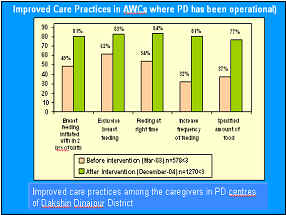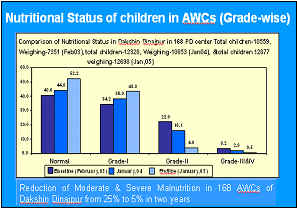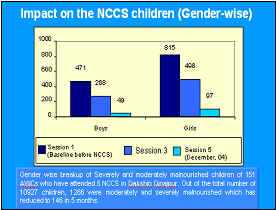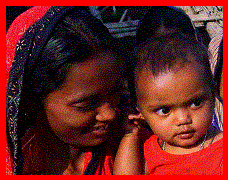 TOWARDS A WORLD FIT FOR CHILDREN
TOWARDS A WORLD FIT FOR CHILDREN
 TOWARDS A WORLD FIT FOR CHILDREN
TOWARDS A WORLD FIT FOR CHILDREN
UNICEF’S
Role in West Bengal for ICDS
(version
May 2005)
In order
to ensure the rights and wellbeing of children
and to develop ‘a world fit for children’,
UNICEF's distinctive mission aims to empower families and communities with
appropriate knowledge and skills to improve the care and protection of children,
expand partnerships as a way to leverage resources for children and strengthen
the evaluation and knowledge base of best practices on children to inform
policy, support programme formulation and enhance monitoring capacity.
UNICEF
collaborates with WCD & SW in India as well as in all the States for ICDS
which is the largest integrated
welfare programme for women and children of GOI. In West Bengal UNICEF works
with the Government for quality improvement of ICDS specially focusing on
“under 3” children for prevention and reduction of malnutrition, to improve monitoring system of ICDS and also to bring about policy
changes for sustainability and institutionalization of the process.
The challenges
The
process of becoming malnourished starts very early – inadequate care of and
discrimination against the young girl child, poor nutrition and health status of
the adolescent girl, chronic energy deficiency and anaemia are some of the key
impending factors. The situation in West Bengal is further aggravated by poor
socio-economic conditions, early marriage, and early and frequent pregnancies.
Together, these result in an unsatisfactory state of affairs: 23 per cent of
children are born with low birth weight, 49 per cent of children under three
years are underweight, 76 per cent of children under three suffer from some
level of anaemia, and only 43 per cent of children are covered by vitamin – A
supplementation. To compound this, 63 per cent of women suffer from different
degrees of anaemia that get further aggravated during pregnancy. Coupled with
early age at marriage, 62 per cent of girls get married below the age of 18
years, this brings us firmly back to the problem of low birth weight --
completing the classical life cycle of malnutrition.
The ICDS
programme in the state initially suffered from two deficiencies: the absence of high
quality nutritional status monitoring system and the absence of an effective
methodology for reduction of existing malnutrition and its prevention among new
entrants. These have been largely addressed through the initiative on
strengthening the surveillance system and scaling up the Positive Deviance
methodology creating capacity at state, district and project level for
assessment analysis and informed multisectoral action for prevention and
reduction of malnutrition (including micronutrient malnutrition) in children
under three years.
Results
 Nutritional Status Analysis
system
Nutritional Status Analysis
system
Earlier,
ICDS data were routinely collected but these were rarely analysed in time,
especially at the district and the project level. This hampered evidence based
planning of activities and affected the quality of programme implementation.
GOWB and Unicef have developed an IT supported, user friendly module for
nutritional status data analysis for children under three years based on the
routine Monthly Progress Report (MPR).This module was easily implemented at the
district level throughout the state. This activity has lead to better focus
within the programme and identified higher regions of malnutrition needing
priority attention for intervention, thus launching of positive deviance
programme.
Achievements so far
v
54,000 AWCs have been equipped with weighing scales and
growth charts which helps in regular weighing of children for early detection of
malnutrition.
v
Computers and user friendly data capturing system have been
provided in all the districts and State ICDS cell.
v
350 ICDS personnel have already been trained (including
State, District & Block level) out of 394 scheduled for training. The
training commenced on April ’03, 141 persons have been trained in the year
2003, 219 persons have been trained in the year 2004.
v
Computerized MPR is being sent from the DPO-ICDS cell to the
Directorate through e-mail regularly from November 2003.
v
Monthly
analysis is now being carried out with the help of Charts and Maps to monitor
the progress of the Nutritional Status.
Above
analysis has led to introduction of an initiative for accelerated reduction and
prevention of malnutrition among children in the 0-3 age group. This approach
termed ‘Positive deviance’ (PD) is quite suitable in areas with high
incidence of moderate and severe malnutrition. It is a strategy that reduces the
burden of malnutrition in a short time and prevents it among younger children by
enabling the community to adapt best local practices in child-care on a
sustained basis. PD
approach therefore acts as a quality improvement tool for ICDS by, v
Improving
weighing of all children under 3 years in the area. v
Early
detection and prevention of growth faltering v
Making
the community identify their own best practices. v
Mothers
of the malnourished children ‘learn by doing’ these practices. v
There
is more efficient utilisation of the food to severely malnourished children. Other
service Quality factors which show improvement are: Immunization
plus (Vitamin A), ANC services, Birth registration, Institutional deliveries,
exclusive breast feeding upto six months, timely and quality complementary
feeding.
Positive Deviance emphasizes on
community involvement and participation, community contribution, behaviour
change through practice. Given
the community involvement in this strategy, PRI representatives play a crucial
role in it. They help mobilize the community based on the evidence of where it
stands vis a vis neighboring areas. They help make issues of nutritional status
visible and insist on convergence of different services in tackling the problem
of malnutrition. Specific items like improvement in nutritional status seen
through community growth charts, observation of fixed immunization days,
conducting the nutritional counseling sessions (NCCS), adapting and sustaining
improved child care practices and management of moderately and severely
malnourished (grade II, III, IV), can be made issues of concern for the
community by these representatives. This process makes the mothers and
care-givers aware of infant feeding practices like exclusive breast feeding,
timely introduction of complementary feeding, feeding during illness, important
of complete immunization, hand washing practices etc. Successful
reduction of the moderate and severe malnutrition does then boost the confidence
of the entire delivery system, provide ICDS with a strategy for a quantum jump
in its performance and create environment for tackling even mild malnutrition.
It releases the initiative of the individual ICDS functionaries bringing about
an overall quality improvement in their functioning. PD
programme has now come of age with its scaling up in Dakshin Dinajpur (all 8
blocks), Murshidabad (10 blocks), Purulia (4 Blocks) and S-24 Parganas (2
blocks). The strategy is also being taken up in other states. It is time
therefore to take stock of where we have reached so far.
Some Results
More Results

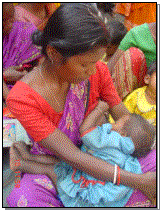 Positive
Deviance (PD):
Positive
Deviance (PD):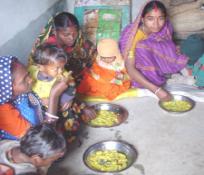 This
is further facilitated by use of various community monitoring tools like village
resource mapping with various indicators, cohort registers (to track pregnant
women to children upto 3 years), mother child protection card (home based record
cards) and community growth charts in the concerned villages. All these
monitoring tools are colour coded so that even if a person is illiterate
malnutrition becomes visible easily.
This
is further facilitated by use of various community monitoring tools like village
resource mapping with various indicators, cohort registers (to track pregnant
women to children upto 3 years), mother child protection card (home based record
cards) and community growth charts in the concerned villages. All these
monitoring tools are colour coded so that even if a person is illiterate
malnutrition becomes visible easily.
